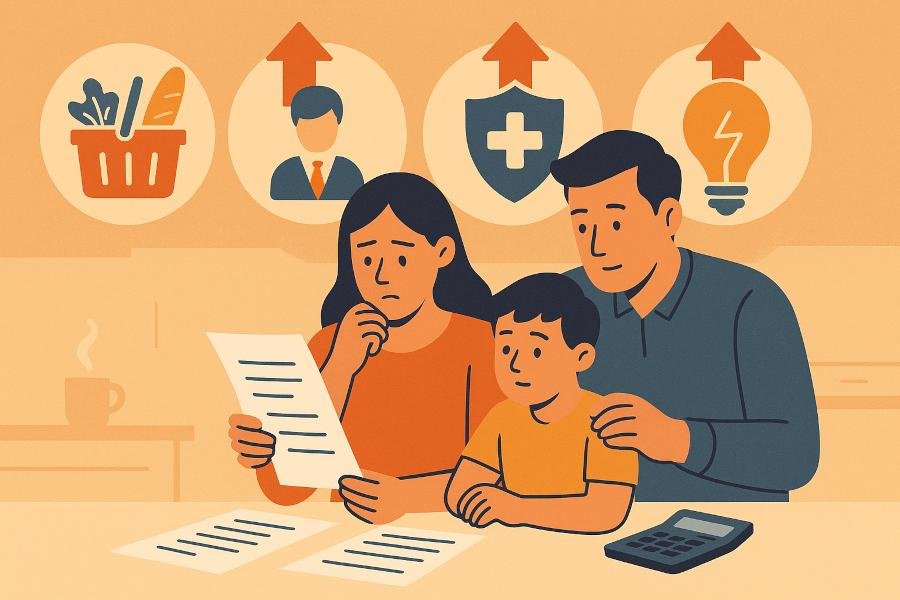If it feels like your money isn’t stretching as far as it used to, you’re definitely not imagining it. Grocery prices have climbed, everyday services cost more, and even essential expenses like insurance and utilities have crept up. Many households are feeling squeezed from all directions, and the pressure hasn’t eased as quickly as people hoped.

This article breaks down what’s driving the cost-of-living crunch, covering rising costs, why inflation has been “sticky,” and what practical steps you can take to protect your budget.
Key Takeaways
- Living costs in the mid-2020s remain elevated due to persistent inflation, supply bottlenecks, labour shortages, and high global energy prices.
- Groceries and consumer goods are affected by transport costs, climate-impacted supply chains, and rising production expenses.
- Service prices have increased because businesses are facing higher wages, insurance premiums, and operational costs.
- Insurance and utilities are rising due to extreme weather risks, infrastructure pressures, and higher wholesale energy prices.
- Households can regain control through simple actions such as budget resets, mindful spending, and smarter price comparisons.
Why Everything Feels More Expensive: A Deep Dive Into Today’s Cost-of-Living Pressures
Groceries: Ongoing Price Pressure in the Weekly Shop
Grocery bills have climbed steadily over the last few years, and many households are still feeling the shock. Several factors are at play:
Supply chain disruptions: Even though global shipping conditions have improved, lingering bottlenecks and transport costs continue to influence prices.
Weather-related impacts: Climate events—including floods, droughts, and heatwaves—have reduced yields and affected food availability, especially fresh produce.
Higher input and labour costs: Farmers and manufacturers face increased costs for fertiliser, energy, packaging, and labour, and these costs are passed on to consumers.
Many countries’ consumer price indexes show food inflation remaining above general inflation through 2023–2024, with several markets experiencing 7–10% annual increases at their peak.
Reference: OECD Food Inflation Tracker
Services: Why Everything From Haircuts to Car Repairs Costs More
Service prices have risen even faster than goods in many economies. This comes down to:
Tight labour markets: Businesses in hospitality, health, retail, personal services, trades, and care sectors have struggled to attract workers, leading to higher wages.
Reference: IMF Labour Market Tightness Analysis
Higher operational costs: Rent, commercial insurance, and equipment costs have increased for small businesses.
Reduced competition: Some industries saw business closures during the pandemic and recovery period, reducing price competition.
For households, this means everyday services—from a plumber visit to childcare fees—cost meaningfully more than they did just a few years ago.
Insurance Premiums: A Consequence of Rising Risks
Insurance has become one of the fastest-rising household expenses. Several insurers have reported large increases in claim costs due to:
Extreme weather and natural disasters: Storms, floods, bushfires, and cyclone activity have increased claim frequency and severity.
Reference: Insurance Council of Australia – Climate Trends
Higher rebuilding and repair costs: Construction materials and skilled trades are more expensive than before the pandemic.
Global reinsurance costs: Insurers rely on global reinsurers to cover catastrophic events, and premiums in this market have also surged.
This combination means home, contents, car, and even business insurance premiums have risen across much of the world—including Australia, the US, and Europe.
Structural Drivers Behind Persistent Inflation
Even though central banks raised interest rates to cool inflation, several structural forces have kept prices elevated:
a) Geopolitical fragmentation
Trade disruptions, sanctions, and reshoring of manufacturing have raised production costs worldwide.
b) Energy price volatility
Energy markets remain sensitive to global political tensions and supply constraints. High wholesale prices flow into electricity and gas bills.
Reference: IEA Global Energy Outlook
c) Ageing populations
Many developed economies are experiencing slower workforce growth, which leads to increased labour costs over time.
d) Corporate pricing power
In some industries, companies have maintained higher margins even as input costs stabilised—sometimes referred to as “price stickiness.”
What Households Can Do: Actionable Strategies to Stay Ahead
While no single family can change global economic forces, there are ways to regain control.
Budget Reset
Give your budget a clean-slate review. Compare current spending to your assumptions from a year ago—you’ll often find silent increases in categories like groceries, subscriptions, fuel, and takeaway meals.
Cost-Trimming Tactics
- Switch to home or store-brand groceries where possible
- Review insurance premiums annually and compare across multiple providers
- Reduce discretionary services (e.g., eating out less or stretching haircut frequency)
- Consolidate subscriptions or rotate streaming services rather than paying for all at once
Smarter Comparison Shopping
- Use price-tracking tools and apps for groceries and household items
- Compare energy plans at least once a year
- Negotiate with service providers (insurance, phone, internet)
- Buy non-perishables in bulk when discounted
Create or Rebuild a Buffer
Aim for even a small emergency fund. With higher economic uncertainty, a buffer can prevent reliance on credit during surprise costs.
Frequently Asked Questions
1. Why hasn’t inflation gone back down to pre-2020 levels?
Because many price increases were caused by structural issues—like labour shortages and energy costs—not just temporary supply shocks.
2. Are grocery prices expected to fall soon?
Most forecasts suggest prices are more likely to stabilise rather than return to previous levels, unless there are major improvements in supply chains or production costs.
3. Why are services getting more expensive faster than goods?
Services rely heavily on labour, and wages have risen in many industries due to workforce shortages.
4. What can I do about rising insurance premiums?
Shop around, adjust coverage where safe, increase your excess, and ask for loyalty or retention discounts each year.
5. Will interest rates come down in the mid to late 2020s?
Economists expect gradual rate cuts in some countries, but only if inflation continues easing. Central banks remain cautious.
6. How can I reduce my grocery bill without compromising nutrition?
Focus on fresh seasonal produce, compare unit pricing, shift toward cheaper proteins (beans, eggs, chicken), and reduce food waste.
7. Why do energy bills remain high even when fuel prices drop?
Energy markets lag behind fuel price movements, and grid, network, and infrastructure maintenance costs contribute to bills.
8. What’s the best first step if I feel overwhelmed by rising costs?
Start with a simple budget audit—just listing current expenses often highlights savings opportunities immediately.




